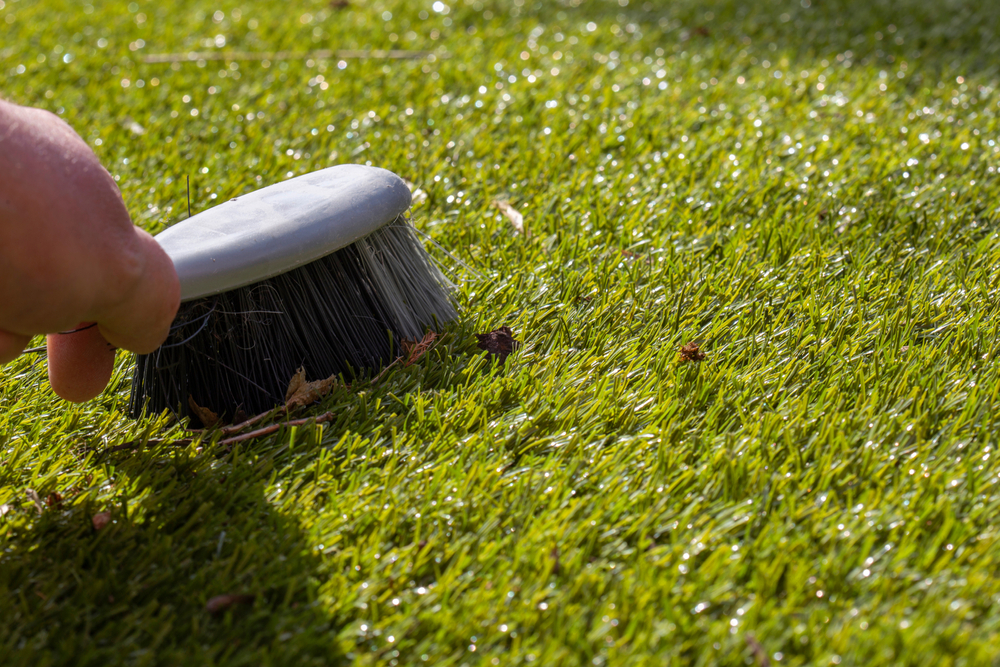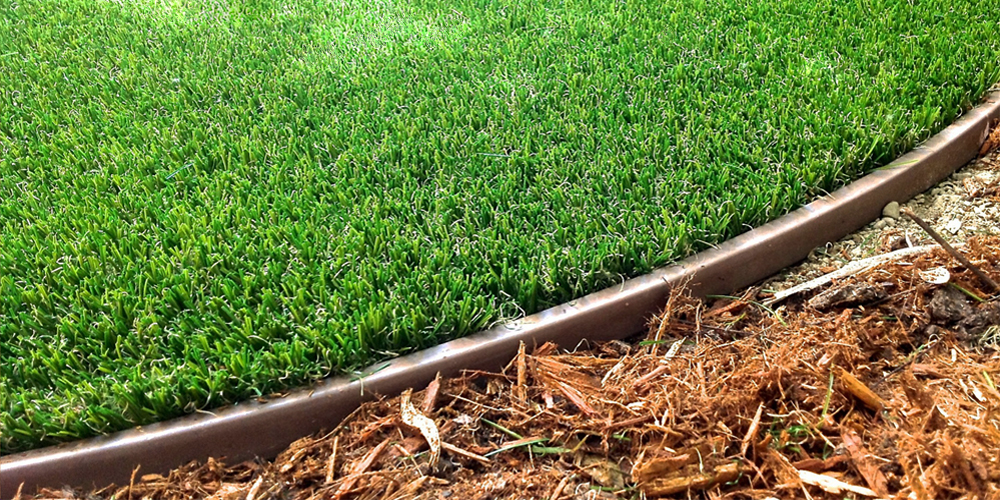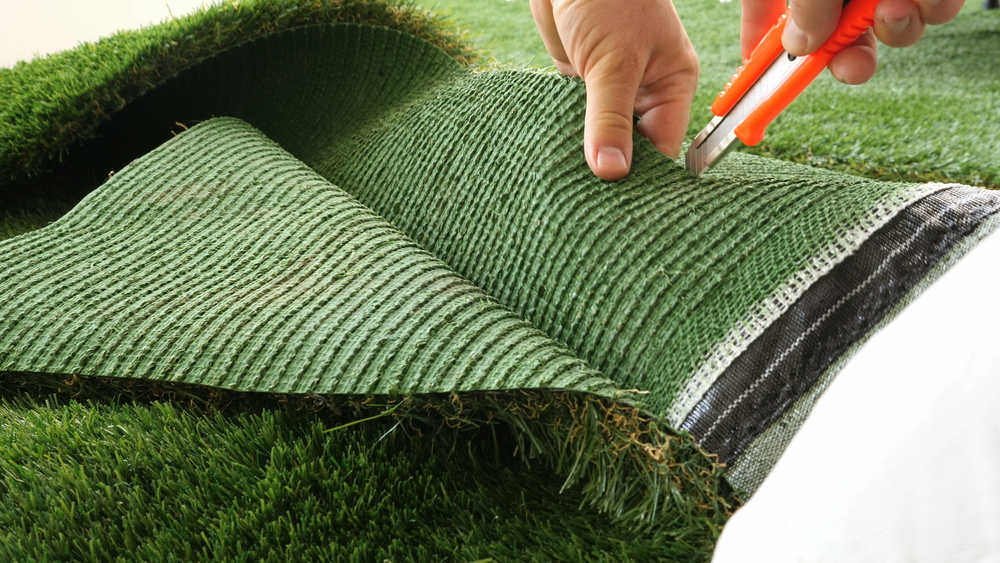Artificial grass is a highly versatile and durable ground covering alternative for small back yards. Not only does it evoke the vibrant green of a fresh, lush and healthy lawn, it is easy to maintain and is soft and comfortable underfoot.
Many people have different reasons for wanting to install an artificial lawn. While it sometimes has a bad reputation because it is manufactured from polypropylene, which is a plastic, if used sympathetically and part of an overall landscape design project, there is no reason why a homeowner shouldn’t enjoy the low maintenance benefits without compromising local wildlife.
Table of Contents
Why would you choose an artificial lawn?

There are many reasons why an artificial lawn may be more suitable than real grass.
Some homes have sloping, shady gardens where water naturally drains away leaving extensive dry areas where the natural lawn is consistently dry and yellow in colour, no matter how much it is watered. An artificial lawn will immediately solve this issue, giving you year round colours and vibrancy.
The elderly, and those with mobility issues, may be unable to get out and properly maintain a large lawn. Real grass requires constant attention to look its best, particularly during the summer months. Even in the winter it requires a certain amount of clearing and care to ensure it enters the spring in a reasonable state. The integration of a fake lawn as part of an overall redesign to eliminate large amounts of work and maintenance will contribute significantly to the aesthetic appeal of a garden – one that will give continued pleasure without the stress and anxiety involved in keeping it looking that way.
Providing a haven for hayfever sufferers
Hayfever sufferers often approach the summer months with trepidation, knowing that increased pollen count will lead to runny, itchy eyes and congested noses. Those with allergies to grass particularly suffer and tend to avoid going out into their own gardens because it makes them feel so poorly.
Artificial grass quite simply does not produce pollen. For those that suffer from hayfever and grass allergies, they can enjoy the benefits of outside living without the damaging effect on them of increased pollen.
Make sure you choose a premium product for longevity

Unless you buy a cheap fake grass product that has no guarantee, your artificial lawn could last for many years – in fact, some of the more premium quality products can last up to 15 to 20 years, giving you year after year of enjoyment. To get the absolute most out of your investment, we have compiled a list of ‘Must Dos’ when it comes to having artificial lawn laid in your back yard. Tick these off and you are on your way to many years of low maintenance, comfortable and relaxing outside living.
Choose a professional installation

Although installation is not difficult, there are a series of strict processes you need to go through to make sure your new installation is done properly. A professional installer will make sure that all the processes are carried out according to the manufacturer’s instructions.
Equally, they will be more knowledgeable about what to do if there are awkward and unyielding areas that need covering – steep slopes, jagged borders around rockeries or ponds, navigating drain covers and utility installations such as washing lines or storage areas.
Number one rule is to ensure there is a suitable sub-base comprised of aggregates and sand that not only give you a stable foundation, but also that good drainage is achieved.
Check your artificial grass accessories
The process of lawn installation is a specialized area that will need specific products such as jointing tape, which will ensure the joins between lawn sections are not visible. However, once completed, the only accessories that you will need to keep your artificial lawn looking in tip top condition is a hosepipe, and a broom, brush or plastic rake, which can be used to keep the dust down and the grass itself clean and free from debris.
While you will have eliminated the need to mow your lawn every week or so, your artificial lawn is not completely maintenance free. Every now and again you will need to get out there and wash and brush it down. Occasional brushing will also help the grass fibres keep in an upright position.
Mix and match with natural garden planting
When incorporated as part of an overall garden design with bedding plants, natural grass, raised beds, shrubs and potted plants, you can still create a space which encourages biodiversity which encourages bees, insects and other wildlife.
Be gentle with it
Although your lawn will be pretty durable and able to withstand a lot of wear and tear, you still need to treat it with gentle care, as you would anything that you want to maintain and nurture for many years to come.
There are certain ‘Do Nots’ which you need to observe.
Do not place hot barbecues on the lawn. Manufactured from polypropylene, the grass fibres are strong and durable, and will keep their colour even in strong sunlight. However, hot coals do not do it any favours. Keep your burgers away from the areas where you have laid the lawn.
Do not park your car on it – the weight of the car will leave indents in the fibres, and any oil spillages or rubber tyre marks will be almost impossible to clean off.
Then, Do not mow the lawn with a lawn mower – it does not grow, so it won’t need cutting at all.
Do not water it. It does not need to be watered as it does not grow. This is one of the real benefits of artificial lawn, and gives households great savings on their water bills. To recreate the aesthetics of an artificial lawn with real grass takes a tremendous amount of time and water. If you do get the oaasional hose on it – it is to simply and quickly wash it down.
Stick to these simple rules and you can be sure of many years of enjoying a blemish free, low maintenance garden.